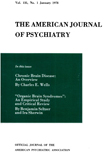Abstract
Recent trends in the psychiatric literature reveal that disillusion with the insulin coma treatment of schizophrenia has steadily spread in the past 4 years. Since the method has no rationale, and since even its empirical basis now cannot withstand critical inspection, it is of interest to know why it gained almost unanimous acceptance.
Probably three circumstances are at the bottom of it. The first is that a movement for the reform of mental hospitals and for their conversion from inactively custodial asylums to therapeutic centres, was bound to grow in the last 20 years. The second is that such a movement would inevitably have promoted treatment methods that involved optimistic and individual attention to psychotic persons. The third is that in the early 'thirties when all this began, schizophrenics were considered inherently inaccessible to psychotherapy, since Freud adumbrated that they were incapable of forming a transference relationship.
It can safely be said, now that this fallacy has been exploded in the last decade, that were insulin coma a new treatment invented in 1958, it would have no hope of catching on in the way it did. It succeeded because it provided a personal approach to the schizophrenic, suitably disguised as a physical treatment so as to slip past the prejudices of the age. The work of Whitehorn and Betz (24) underlines this point most lucidly. Comparing two groups of psychiatrists, the one psychotherapeutically effective with schizophrenics, and the other ineffective, they found that only the results of the latter were enhanced by insulin coma therapy.
In short, insulin coma treatment may come to be remembered as the first application of psychological healing for schizophrenics in the mass, and its achievement as an inadvertent one—the supply to persons hitherto considered impervious to it, of daily, devoted, personal care.
In 1958, there are more rational ways of doing this, but apart from its irrationality, the insulin treatment exposes both patient and psychiatrist to a number of hazards which are no longer justified. It has a mortality which is not negligible; it is extravagant in the scarcest of mental hospital commodities, namely medical and nursing time; and worst of all, it effectively screens doctor and patient from other approaches to the problems of schizophrenia.
The psychiatrist in training probably suffers most damage. Juniors are often posted to the insulin unit so that, at its foundations, their knowledge of schizophrenia requires no preoccupation with its subtle psychology and no experience of psychotherapy. Even the proper use of ECT is impeded because it is learnt as a casual procedure, administered sporadically and without system, as an adjuvant to the insulin ritual. One consequence of this is that the phenomena of convulsion dependence(8) are obscured and their correct management subverted.
No doubt, the insulin treatment will be slower to depart than it was to be accepted. The "it-can't-do-any-harm-to-try" argument is not only destitute, it is false and dangerous for both patient and psychiatrist.

